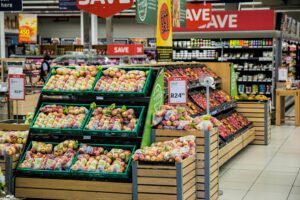Last week brought a lot of news on the dairy market and obviously some price fluctuations. In this issue of our newsletter we have prepared for you some longer insights into the selected commodities, so you have the opportunity to get to know them first.
In the case of this week’s product overview, we can recall the quote by Miguel de Cervantes: ‘Take away the cause and the effect ceases’. This phrase can be perfectly applied to the functioning of the market, as we observe that the prices we are currently dealing with depend on many different factors, including the weather, the mood of buyers and others. Be sure to check our view on these processes.
What is happening in different parts of the world when it comes to dairy products? As always, it’s up to the region. There’s a lot going on in the Americas, where we are seeing numerous unexpected events. As for Europe, Asia and Oceania… we will not give it all away in the introduction.
Continue reading to learn about this week’s market insights.
With us, you’ll never miss a thing!
Butter
Another week in a row, the commodity cream has experienced a price correction. There is plenty of this material on the market and no problems with availability, which translates into lower prices for Butter among producers. Unfortunately, there are more sellers with filled warehouses than prospective buyers. This is also related to the fact that some buyers have already gone on vacation. Nevertheless, we had quite a lot of interest for butter with Q3 deliveries last week.
Skimmed Milk Powder
Despite the hot weather in many regions of Europe and the resulting drought, raw material as such is abundant. As a result, the price of Skimmed Milk Concentrate has fallen for another week in a row, and the commodity is available in France at just below 2000 EUR/MT. Trading houses offer the product already produced and therefore it is difficult to get a relatively good price for the fresh product.
Gouda/Edam
Cheese has been the hottest commodity on the market in recent weeks. We have had a lot of inquiries about these products. The great interest has also been reflected in a high volume of contracts signed. Particular activity and interest in these products were shown by tourist countries, which have to satisfy the needs of holidaymakers.
Whey Protein Concentrate 80%
In the last two weeks, some producers have increased prices for WPC 80% by almost 10%, as interest has increased, especially from outside the European Union. Producers have raised prices and some customers have backed out as they have not been able to pay the required prices. This is also because they are still expecting deliveries from previous contracts, where the price started at 4.
Cream
The price of the commodity has fallen and the availability is very good, which is typical for this period.
Europe
New price cuts for milk in the UK.
One of the most prominent supermarket groups, Sainsbury’s, announced on Thursday that it is cutting the price of own-brand milk for the second time in three months. The decision is another indication that the rise in food inflation could moderate this year. Britain’s No. 2 grocer said that starting last week, four pints of milk will cost 1.45 pounds ($1.83) instead of 1.55 pounds, while two pints will cost 1.20 pounds instead of 1.25 pounds. Following Sainsbury’s move, online supermarket Odido has also cut milk prices.
UK milk producers were called on to conduct genetic carbon audits.
Milk producers have been asked to participate in genetic carbon audits as part of a drive to net carbon zero. Improving genetics is the cheapest and most effective way to improve dairy herd performance in a stable, long-term manner. New data show that this is as true for the carbon footprint as it is for any other animal trait passed down through the generations.
Hungary introduces new regulations and tightening in the domestic dairy industry.
The fluctuations in the milk production sector are significant. Due to the size of Hungary, they only follow the processes of the European milk market. The Ministry of Agriculture is trying to help the companies in the dairy industry on the regulatory, control, and support side. Last year, the Common Agricultural Policy (CAP) Strategic Plan 2023-2027 was adopted, in which about two-thirds of production support is allocated to animal husbandry. The aim is to make the support period predictable and plannable for farmers.
The Americas
Milk prices in the U.S. continue to fall, to not expected levels.
The last time we saw Class III this low was in 2018 and 2020. Fluid (beverage milk) sales continue to be below last year’s levels and will continue to decline over the summer when schools are out. Butter and cheese sales were slightly higher than a year ago, but Cheese sales are not at levels to support prices. Dairy exports set a record in 2023 with strong cheese exports. But according to recent news, global demand for dairy products has weakened while competition from Europe and New Zealand has increased. Inflation and the economic slowdown have dampened consumer demand.
Through excessive imports, Brazil generates an unprecedented crisis.
Thousands of milk producers in Santa Catarina are abandoning their activities due to the new situation in the Brazilian market, which is characterized by excessive imports of milk and the continuing drop in wages. This year, Brazil has already imported 850 million liters of milk mainly from Argentina and Uruguay, an amount that last year was only reached in September. The price of milk on the world market fell and the Brazilian currency, the real, appreciated against the dollar. The mixture of these two factors stimulated imports and the price on the domestic market collapsed.
Uruguayan dairy farmers are concerned about the increase in debt.
With little room for maneuver, uncertainties in the international market, and higher expenses, dairy farmers are more than worried because their debt has accumulated for the spring. No matter what happens, there will not be enough milk to pay off that debt. The spring was good, but there are still many expenses, such as seeds. ‘No doubt these expenses will be a problem, no matter how good the season was,’ dairy producers say. Production problems continue, and in the north of the country, producers have reloaded properties with heifers.
Asia & Oceania
Import of milk products had been ruled out in India.
While ruling out the import of these products in the coming months, India’s representative said that the country has a sufficient amount of skimmed milk powder (SMP) and that the milk chain is functioning smoothly. Milk prices have increased, but the government claims it is doing its best to solve the problem by increasing milk production and availability. There have been reports of shortages, but officials claim the problem is ’made up’ and the reality is different. They have not provided any timeline for lowering milk prices.
China is gradually recovering from the COVID -19 pandemic.
They have optimized their response to the epidemic, as evidenced by their consumption of dairy products. The comments came as New Zealand’s prime minister visited China on Sunday. He brought with him a business delegation of 29 representatives from various sectors and companies, including New Zealand dairy giant Fonterra. Fonterra’s representative in China said the company had been eagerly awaiting his visit and believed it would have a positive impact on bilateral relations, as they expected more practical economic cooperation was expected.
The situation of the raw milk industry in China is constantly changing.
The price of domestic raw milk has fallen below 4 yuan/kg this year. Under the cost pressure, dairy farms are facing great challenges. Factors such as weak demand in the consumer market and other factors have led to a continuous decline in the price of raw milk. Its prices continue to fall. Problems such as low prices and poor sales of this product are common and faced by most producers, especially small and medium-sized farms.







